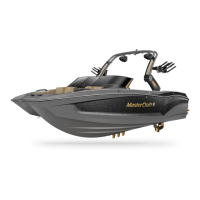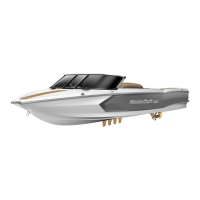should be oiled one or two times a month during the rst season; then
as needed after that. The platform should be covered when not in use
or when stored for the winter.
Many products such as boiled linseed oil, tongue oil, teak oil and
other outdoor wood preservatives can be found at marinas, paint
stores or home improvement stores. Some oils such as linseed oil
should be thinned with a thinner like mineral spirits before use. (70
percent oil-30 percent thinner.)
When oiling a platform, apply a coat of oil with a wet cloth, work
into the seams, end grain and edges. Allow the oil to set approximately
15 minutes and then wipe off the excess oil with a dry cloth. Do not
let the oil dry on the platform in the sun. Excess oil should be
removed with a dry cloth.
Teak inlay platforms:
Wear proper boating shoes. Avoid black-soled shoes as they are likely to
scuff the surface, resulting in marks that may be difcult to remove or even
leave permanent marks that are not covered under warranty.
The teak inlay platforms feature a specially developed synthetic
surface that is durable and long-lasting, provided proper care is given
to the inlay surface. This maintenance is different from the full teak
platform care.
For the inlay, note:
• Inlays do not require oiling or special sealants.
• Inlays can be maintained by pressure washing.
• Do NOT place hot metals of any kind on the inlay surface.
This will create a permanent mark.
• Do NOT use acetone to clean the inlay (or berglass
surround).
• Do NOT use oil, bleach, varnish, paint or lacquer.
• Do NOT use a power sander.
Most spills will brush away with soap and water, using a bristled brush
and boat deck cleaner. After cleaning, rinse with water and allow to air dry.
Sanded areas will appear lighter after sanding and will blend in with the
surrounding areas within a day or two. If a chemical stain is allowed to dry
and soap and water do not remove it, the surface can be lightly sanded
with 60-grit sandpaper. Sand the stain in the same direction as the black
caulk seams. Sanded areas will appear lighter after sanding and will blend
in with teh surrounding areas within a day or two.
If bleach is used on areas surrounding the teak inlay deck, rst
spray the surface with water to dilute any bleach that may run onto
the deck surface. After cleaning the other area(s) with bleach, re-spray
both the bleached surfaces and the teak surfaces to rinse away any
bleach residue. Note that bleach should never be applied directly
to the teak!
Fiberglass Swim Platform
The berglass swim platform requires the same kind of regular—
and gentle—cleaning that the rest of the boat needs. After cleaning off
any environmental debris, wash with mild soap and warm water. Avoid
the use of ArmorAll or similar types of rubber-shine products as these
will speed the decay of the rubber rather than protecting it.
Windshield
In cleaning tempered glass windshields, the normal glass cleaners
(from spray bottles or aerosol cans) work best. While the glass is very
strong, it can be scratched if anything abrasive is used. Harsh chemi-
cals or solvents should be avoided because they may affect the vinyl
gaskets or powder-coated nish on the extrusions.
More care should be taken when cleaning the clear Eisenglass cur-
tains, which are an option on some boat models. Eisenglass curtains
are usually made with clear vinyl sheeting, which is much softer and
more prone to scratching and hazing than the windshield glass is, only
soft cloths and mild detergents should be used.
mastercraft 2010 ow n e r ’s m anual • page 14 -2
All teak platform
Teak inlay platform
Fiberglass platform

